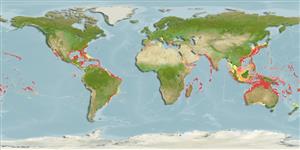Gymnolaemata |
Ctenostomatida |
Vesiculariidae
Environment: milieu / climate zone / depth range / distribution range
Ecology
Sessile; depth range 1 - 145 m (Ref. 86508). Tropical
Native in Caribbean and Atlantic Ocean, introduced in Indo-West Pacific.
Length at first maturity / Size / Weight / Age
Maturity: Lm ? range ? - ? cm Max length : 20.0 cm WD male/unsexed; (Ref. 3248)
Fragile; colonies erect with many free branches. Dichotomously branching in series of two with thin stolon. Usually grows to a height of 4 to 5 cm. Transparent colonies in pale yellow to brown.
Depth range reported from Colombia (Ref. 86508). Epibenthic, encrusting (Ref. 116066). In cool temperate to tropical waters (Ref. 874). Grows on varied surfaces: other bryozoans, algae, seagrasses, oyster valves, sandstone boulders, dock, pilings, breakwaters and man-made debris (Ref. 83404).
Life cycle and mating behavior
Maturity | Reproduction | Spawning | Eggs | Fecundity | Larvae
Members of the phylum Bryozoa are hermaphroditic. Both fertilization and egg brooding may either be internal or external.
Soule, J.D. 1963. (Ref. 874)
IUCN Red List Status (Ref. 130435)
CITES status (Ref. 108899)
Not Evaluated
Not Evaluated
Threat to humans
Human uses
| FishSource |
Tools
More information
Age/SizeGrowthLength-weightLength-lengthMorphologyLarvaeAbundance
Internet sources
Estimates based on models
Preferred temperature
(Ref.
115969): 21.8 - 28.7, mean 26.9 (based on 1800 cells).
Vulnerability
Low vulnerability (10 of 100).
Price category
Unknown.
